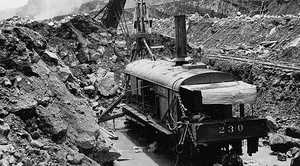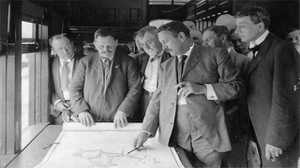The Canal Today
Widening the shipping lanes and constructing new, more efficient locks to allow for a third lane of traffic are the top priorities for the Panama Canal Authority (ACP), which is striving to meet the needs of the modern-day shipping industry. The project, scheduled for completion in 2014, in time for the canal's centennial anniversary, began operation in June 2016.

Since the first ship passed through in April of 1914, the Panama Canal has been at the center of global trade. By 1939, more than 7,000 ships a year were traveling through the canal, but it did not turn a profit until the 1950s. In 1966, the lines at each end of the canal had grown so long that the ACP installed lighting to allow for overnight traffic.
In recent years the amount of cargo shipped worldwide annually has continued to increase, a growth driven in part by rapidly expanding economies in Asia. By 2005, 5% of worldwide shipping traffic was passing through the Panama Canal, including nearly 70% of all cargo to and from the U.S. In 2007 -- the year construction began -- 14,721 vessels carrying a record 313 million tons of goods crossed the canal. Experts estimate that by 2025 annual demand will rise to 510 million tons.

The overwhelming number of ships requiring passage through the canal has lead to bottlenecks that delay ships by 20-30 hours on average. Some of the larger shipping companies pay to avoid the wait. In 2009, BP Shipping paid an additional $220,000 to cut to the front of the line.
The amount of shipped cargo increasing is not the only issue; vessel sizes have grown as well. Panamax ships -- a name that describes the maximum sized ship that will fit through the Panama Canal -- are no longer the industry standard. "Post-Panamax" ships, which include many oil tankers, liquefied natural gas carriers, and bulk carriers, are too big to pass through the canal's lock system. By 2011, 37% of the world's container ships are estimated to be Post-Panamax.
Under the 2007 construction plan, the Panama Canal Authority is planning to double the capacity of the canal. A new set of post-Panamax-sized locks will allow for a third lane of traffic measuring

1,400 feet long, 180 feet wide, and 60 feet deep. Five miles of new post-Panamax-sized approach channels will lead up to the new locks, and both the Pacific and Atlantic entrances will be deepened to 740 feet wide and 51 feet deep. The CPA will deepen Gatun Lake by five feet and nearly double its width, allowing millions more gallons of water to collect in the lake. Finally, they will install new a lighting system for the locks.
Engineers in 2007 confronted a host of local environmental concerns, first and foremost was water conservation. The CPA developed a system to reuse 60% of the water consumed on each transit.

Alongside the new locks, the CPA is building 18 water basins that measure 230 feet wide, a quarter of a mile long, and 18 feet deep. The basins will collect water from each lockage and reuse it for the next transit, ultimately losing 7% less water per transit than in 2007.
In all, more than 130 million tons of earth will be excavated -- more than half the amount of earth removed during the canal's construction. The project is slated to create up to 45,000 new jobs, increasing employment on the canal by 10-15%. When construction is completed in 2014, the Panama Canal will be capable of handling up to 600 million tons of cargo per year and seven additional lockages each day. By 2025, the Panama Canal is projected to earn more than $6 billion annually.
Originally published in 2011.








